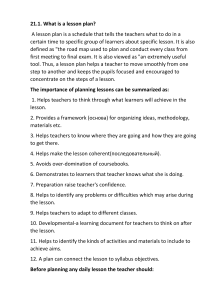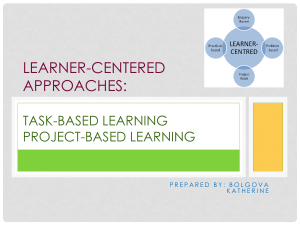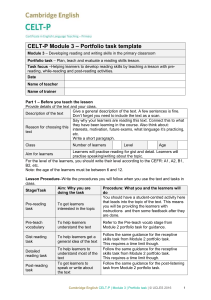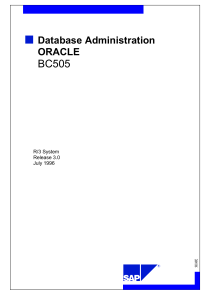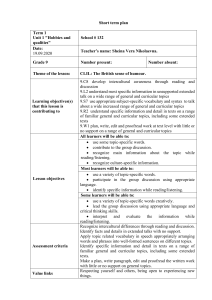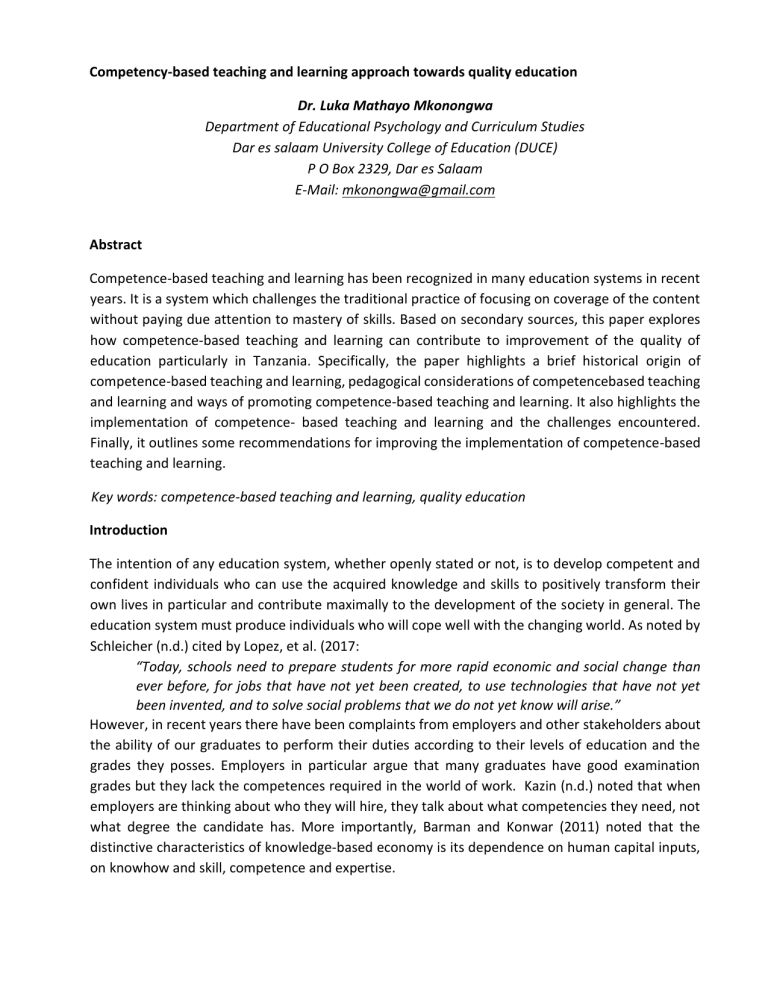
Competency-based teaching and learning approach towards quality education Dr. Luka Mathayo Mkonongwa Department of Educational Psychology and Curriculum Studies Dar es salaam University College of Education (DUCE) P O Box 2329, Dar es Salaam E-Mail: [email protected] Abstract Competence-based teaching and learning has been recognized in many education systems in recent years. It is a system which challenges the traditional practice of focusing on coverage of the content without paying due attention to mastery of skills. Based on secondary sources, this paper explores how competence-based teaching and learning can contribute to improvement of the quality of education particularly in Tanzania. Specifically, the paper highlights a brief historical origin of competence-based teaching and learning, pedagogical considerations of competencebased teaching and learning and ways of promoting competence-based teaching and learning. It also highlights the implementation of competence- based teaching and learning and the challenges encountered. Finally, it outlines some recommendations for improving the implementation of competence-based teaching and learning. Key words: competence-based teaching and learning, quality education Introduction The intention of any education system, whether openly stated or not, is to develop competent and confident individuals who can use the acquired knowledge and skills to positively transform their own lives in particular and contribute maximally to the development of the society in general. The education system must produce individuals who will cope well with the changing world. As noted by Schleicher (n.d.) cited by Lopez, et al. (2017: “Today, schools need to prepare students for more rapid economic and social change than ever before, for jobs that have not yet been created, to use technologies that have not yet been invented, and to solve social problems that we do not yet know will arise.” However, in recent years there have been complaints from employers and other stakeholders about the ability of our graduates to perform their duties according to their levels of education and the grades they posses. Employers in particular argue that many graduates have good examination grades but they lack the competences required in the world of work. Kazin (n.d.) noted that when employers are thinking about who they will hire, they talk about what competencies they need, not what degree the candidate has. More importantly, Barman and Konwar (2011) noted that the distinctive characteristics of knowledge-based economy is its dependence on human capital inputs, on knowhow and skill, competence and expertise. It is for this reason that there is a shift from traditional content (knowledge)-based teaching to competence-based teaching and learning (CBTL). A content-based teaching and learning is based on the rote memorization of factual knowledge while competence-based teaching and learning focuses on understanding the concepts, skills and competencies which in turn calls for changes in teaching, learning and assessment approaches (Posner, 1995).This paper , therefore, analyses the shift to CBTL as a strategy toward the quality of education in Tanzania. Specifically, the paper highlights the conception of CBTL, a brief history of CBTL, the main elements of CBTL approach, how CBTL can improve quality of education, ways of promoting CBTL, challenges of implementing CBTL and finally provide recommendations. Brief history of competence-based teaching and learning The history of competence-based curriculum can be traced back to the early 1970s when competence based education emerged for the first time in the United States of America (Richard & Rogers, 2001). It is an educational movement that define educational goals in terms of precise measurable descriptions of knowledge, skills, and behaviours students had to posses at the end of the course of study. Thereafter, the movement spread into European countries such as the United Kingdom and Germany in the 1980s (Wolf, 2001). Other countries worldwide have been motivated to implement the competence-based curriculum in schools due to the ever changing technology and global market. In Africa, competence-based curriculum was adopted for the first time in South Africa in 1998, following the acute shortage of professionals like engineers, technicians and artisans. South Africa adopted the competence based curriculum in a bid to change attitudes of all South Africans and equip them with employable skills to cope with challenging issues in the 21st century. The concept of competency-based teaching and learning Before defining the concept of competence-based teaching and learning it is important to understand the term competence. According to the Department of Mines, Industry, Regulation and Safety of Western Australia (n.d.) competency is defined as the capability to apply or use the set of related knowledge, skills, and abilities required to successfully perform ‘critical work functions’ or tasks in a defined work setting. Competencies often serve as the basis for skill standards that specify the level of knowledge, skills, and abilities required for success in the workplace as well as potential measurement criteria for assessing competency attainment. Competence is a measure of both proven skills and proven knowledge. It can be viewed in terms of behavioral competence (soft skills) - how something is done and functional competences - the ability to perform some technical task like operating machinery, making a dress, etc. The concept of competence-based teaching and learning mean different things to different people. In fact there is no single agreed definition of the concept because professionals define it from different contexts. There are many terms used to refer to competence-based teaching and learning. Such terms include competence-based education, competence-based curriculum, proficiency-based education, outcome-based education, mastery-based education, standard-based education and performance-based education. Regardless of the context, competence-based teaching and learning refers to the systems of instruction, assessment, grading and academic reporting that are based on students demonstrating that they have learned the knowledge and skills they are expected to learn as they progress through their education. Competence-based curriculum is a functional approach to education as it emphasizes life skills and evaluates mastery on skills, necessary for and individual to function proficiently in a given society (Savage, 1993). Equally important, Mosha (2012) notes that a competence based curriculum seeks to develop in learners the ability to know, to learn and learn how to learn, to do things, and to learn and work with other people. Such a shift has pedagogical implications as Rutayuga (2014) notes that competence-based curriculum requires a shift from assessing a set of learning content to assessing each learning outcome. Similarly, Wood (2001) insists that the move towards competence based rather than content based curriculum necessitates student-centered teaching and learning. To some scholars, such as Harris, Guthrie, Hobart and Lundberg (1995), competence based curriculum is perceived as a solution to the implementation of education and training for the complex contemporary world. Difference between traditional content-based learning and competency-based teaching and learning Traditional content-based teaching and learning differ from competency-based teaching and learning in many ways. Table 1 shows such differences: Content-based teaching and learning Competence-based teaching and learning 1. Is focused on a narrow set of academic outcomes and fails to recognize that student success is dependent on a full range of foundational skills, including social-emotional, and the application of skills. Is designed to help students learn academic knowledge, the skills to apply it and lifelong learning skills that are needed to be fully prepared for college, career and life. 2. Is time-based. Schools batch students by age and move them through the same content and courses at the same pace. Students advance to the next grade level after a year of schooling regardless of what they actually learned. Is based on learning: students must demonstrate mastery of learning, with schools monitoring pace and offering additional supports to meet timebound targets. 3. Uses academic grading practices that can often send misleading signals about what students know by reflecting a mix of factors, including behavior, assignment completion and getting a passing grade on tests, not Grading in competency education is designed to communicate student progress in learning academic skills and content as well as the skills they need to be lifelong learners. student learning. 4. Relies upon a bureaucratic, hierarchical system that perpetuates traditional roles, cultural norms and power dynamics that doesn’t support inclusivity and cultural responsiveness. Seeks to create an empowering, responsive system that is designed to build trust and challenge inequity 5. Is built on a fixed mindset — the notion that people’s “abilities are carved in stone”. In contrast, a competency-based education system is built upon a growth mindset with a belief that all children can learn with the right mix of challenges and supports 6. Depends on extrinsic motivation. It fosters intrinsic motivation by activating student agency and providing multiple opportunities for learning to the same high standards. 7. Emphasizes covering the curriculum and fails to reflect the learning sciences about what we know about how children learn In this system everything should be rooted in what we know is best for students in terms of engagement, motivation and learning. 8. Is organized to efficiently deliver curriculum and assessing students’ proficiency at low levels such as memorization and comprehension of content knowledge rather than applied learning and mastery This education is organized to personalize learning and support the development of higher order skills such as analysis, evaluation and problem-solving. 9. Has high variability in how teachers determine proficiency. It builds educators’ capacity to make judgments of student mastery to the same high standards and calibrated for consistency with other teachers 10. Ranks and sorts students creating “winners” and “losers” and perpetuating patterns of inequality in society. It meets students where they are to ensure that each one can be successful to the same high collegeand career-ready standards. Notwithstanding the place competence-based teaching and learning is adopted, there are some key features which make it unique. Such features include the following: 1. It is student-centered The learner is the focus of the learning process. Individual learners’ needs and learning styles are given priority in determining the content to be covered, the teaching and learning methods and the mode of assessment. 2. It is outcome-based Students must demonstrate mastery of all required competencies to earn credit or graduate or advance to the next level. 3. Involve multiple measures of assessment to determine competency Students earn credit toward graduation in ways other than seat time and course taking (such as apprenticeships, blended learning, dual enrollment). 4. Practice oriented Students must demonstrate practical skills and tangible outcomes to determine competence and not just the possession of theoretical knowledge. Pedagogical considerations in competency-based teaching and learning While advocating for a paradigm shift from content-based teaching to competence-based teaching and learning, it should not be taken for granted that content is no longer important. Instead, as Hong’s (2012) noted the whole idea of competence- based teaching and learning suggests the need for teachers to focus on teaching their learners the importance of valuing their learning process and reflecting on it so they can develop their skills in learning to learn and develop the key competencies. Hong (2012) believes: “what competency-based curriculum requires is reforming the way content knowledge is organised and brought to students, not denying its value”. Competency-based teaching and learning must include attention to the learner’s needs and styles, providing the time needed for the learner to acquire and repeatedly perform or demonstrate the expected competencies (knowledge, skills, professional behaviours) and creating a supportive environment for learning. Competency-based teaching and learning can be pursued through various teaching approaches. However, all curricula need to be evidence-based and outcomefocused and all teaching strategies need to be matched to their learning domain (psychomotor, cognitive and affective). Competence-based teaching and learning emphasizes on powerful or rich learning environments that enable students to engage in meaningful learning processes. The most distinctive pedagogical features of this approach are as follows: Meaningful contexts The teacher will create or to look for meaningful contexts in which students will in a natural way experience the relevance and the meaning of the competences to be acquired. Multidisciplinary approach Competences are holistic and as a consequence the educative approach needs to be integrative and holistic too. Constructive learning Philosophically, competency-based teaching and learning has its roots in the social constructivism. Therefore, learners engage in a process of constructing their own knowledge by interaction with their environment, rather than as a process of absorbing the knowledge that the traditional teacher might try to transfer to them. By focusing on the construction of models, products, guidelines, rules of thumb, reports, or other tangible outputs the learning easily and naturally will turn out to be constructivist. Cooperative, interactive learning (with peers, teachers.) The central idea under competency-based teaching and learning is to help learners to develop and construct their own knowledge and seek ways to make optimal use of other people’s competence in their learning journey. This is what social constructivism is about. For learning outcomes aimed at developing individual and personal competences, the approach must take diversity of learner needs into consideration to meet the leaners goals and objectives. This requires an open approach in which education includes dialogues between learners and educators about expectation, needs, goals, choices etc. Discovery learning Discovery learning as opposed to receptive learning means making content available and accessible and that the way of acquiring this knowledge or competences, could not be just a process of providing information, but should always be embedded in a discovery-based approach. Learners themselves discover theories, rules and patterns as they interact with the environment, peers and teachers. Reflective learning Competency-based teaching and learning also focuses on the learning processes of the learner. Learning is always in a spiral-fashion, that is, it requires learners to go back and fro to reflect on their learning. As the learner reflects on their own needs, motivation, approach, progress, results etc. they develop learning competences that may be considered “learning to learn”. Personal learning In the competence oriented theories learning is conceived as a process of constructing the learner’s own personal knowledge and competences. Information, knowledge, strategies, only become meaningful for a person if they become an integral part of their own personal body of knowledge and competences. In education this implies that students need to be able to identify with the contexts, the persons, the situations and interests that are included in the learning domains involved. How to promote competence-based teaching and learning in schools There are several ways that can be used to make competency-based teaching and learning more effective in the schools. The following are some of the ways: i. Improved teaching methods Competence-based teaching and learning requires teachers to revise and improve their teaching and learning approaches. Gabriel (2010) found that teachers were unable to use highly and potentially interactive teaching methods such as problem-solving and discovery which are very useful in competence-based teaching and learning environment. Traditional teacher-centred approach is no longer appropriate if learners are to demonstrate mastery of the skills they learn. However, Mosha (2012) found that when competence-based teaching and learning was not effectively implemented there was often the danger for teachers to slide back to traditional teaching methods. Teachers, therefore, need to be highly proficient in the application of new teaching methods necessary to make students’ learning effective (Kafyulilo et al., 2012).Teaching should be shifted to learner-centred approach in which the learner takes control of the learning process while the teacher becomes a facilitator of the learning process. Learners in a competencebased learning environment are considered as active participants in the construction of knowledge. ii. Enhance teacher-student interaction Teacher-student interaction is an important aspect in ensuring efficient and effective teaching and learning. Essentially, the objectives of competence-based teaching and learning focus on teachers’ effectiveness in the use of interactive, participatory teaching and learning techniques and a child learning environment. Learners come to class with some knowledge and skills. This prior knowledge which learners bring with them is an important input for effective teaching and learning. In order for the learners to share their knowledge and skills with that of the teacher in the class, teachers must create a friendly and interactive learning environment. Learners should feel free learn from each other and to contribute their ideas and perceptions regarding the subject matter. In the course of this interaction, teachers need to motivate and honour the contributions learners make in the lesson. In addition, teachers stand as moderators of the interactions going on in the learning process. In this way, learners not only develop communicative competences and confidence in expressing their views but also mastery of the subject matter. iii. Improve infrastructure Learning and teaching infrastructure are crucial in building learning competences among learners. This means that the presence and the conditions of classrooms, laboratories, workshops, libraries, sports fields and power and water supply have great influence in the development of competencies among learners. Learners have great opportunities to learn various things when infrastructure are available and are in good condition. For instance, learners preferring to learn natural sciences will be interested to see well equipped and functional laboratories. iv. Motivate teachers and learners Both teachers and learners need to be motivated in order to implement competence–based teaching and learning. On their side, teachers need to be motivated to help learners to develop skills (competences) required. The learners, on the other hand, will be motivated to learn particular skills if they have been informed about the value of such skills in the daily lives. Many learners are forced by curriculum to learn things they do not know why they are learning and how and where they can apply such knowledge and skills in their daily lives. As a result they become rote learners who rely very much on memorization and less on understanding. v. Improve Education policy The implementation of competence-based teaching and learning calls for a review and rethinking of education policy. As mentioned earlier, competence-based learning environment requires a learner to take charge of the learning process. In order for the learner to have enough time to learn particular skills, there must be a relatively manageable number of subjects to concentrate on at a time. When the curriculum is highly loaded, learners lose concentration and consequently they become jacks-ofall-trades but masters of none. In this regard, there a need for policy reform to allow students to study few things but intensively. For example, a subject combination with three subjects at advanced secondary education (A-Level) in Tanzania may not be appropriate for learners to develop competences in particular subject areas. vi. Improve teaching and learning resources The development of competencies among learners requires schools to have all the necessary teaching and learning resources. These resources include laboratory equipment, books, and wall maps, technological tools (such as computers and machineries), and other real objects. As the students use these resources, they gain not only abstract knowledge but also practical skills. vii. Enhance Practical training There is a common saying that “practice makes perfect”. This means that competences are developed when learners engage in practical activities. In a competence-based teaching and learning it is required that students be engaged in various practical experiences (in and outside the classroom) that give them opportunities to apply their knowledge and skills to solve problems. This is accomplished through involving students in hands-on activities which enable them to gain experiences that have a far reaching impact as far as the students’ comprehension of the taught content is concerned (Wangeleja, 2010). To achieve this goal continuous in service-training for teachers is very important. viii. Identify, define and promote Career choice/paths at an early age Early career choice is crucial in the development of learners’ talents and interest in a particular field of study. Apart from teaching, teachers have the role to guide their learners to make informed choices of their future careers. Learners often study a lot of subjects in schools without having knowledge of the application of each subject in their daily lives. The teachers’ usually focus is on accomplishing the syllabus and not on identifying and defining learners’ abilities and talents so that they can be guided to choose their future careers. Teachers are supposed to explain the importance of each subject and topic in the lives of the learners. This information will help learners to link the subjects or topics with the careers of their dreams. ix. Teacher-student ratio improved For teachers to be able to control the class and help each individual student to develop their skills, a standard number of learners per teacher must be established and adhered to. Crowded classrooms detract teachers from knowing and helping all students in the classroom. x. Technology use enhanced The development of information and communication technologies (ICTs) in particular has transformed teaching and learning. With the aid of technology, students are able to explore various sources of knowledge. xi. Assessment procedures improved Competence-based teaching and learning requires multiple ways of assessing learners in order to determine their competences. The implementation of CBC requires the use of new assessment strategies aligned with the new paradigm. To implement these changes it is necessary that all teachers become knowledgeable and equipped with new alternative approaches to assessment (Maclellan, 2004). xii. Teachers’ knowledge of competence based teaching and learning improved Knowledge and understanding of teachers constitute an important aspect in the implementation of competence-based curriculum during the teaching and learning process. Indeed, the effectiveness and efficiency of CBC depends on teacher’s ability to carry out teaching and learning activities responsibly and effectively. Mosha (2012) points out that qualified teachers with ample and appropriate knowledge and skills are one of the pre-conditions for a successful implementation of CBC. Therefore the need for changes in the instructional approaches, calls for the need to equip teachers (both in-service and pre-service) with the necessary competencies for handling new teaching paradigm (Woods, 2008). Implementation of Competence-based teaching and learning in Tanzania The education system which Tanzania adopted from the colonialists was based on knowledge acquisition. Many reforms have taken place in the education since independence but from 1995, when the Education and Training Policy was developed, most of the reforms focused on improving access, equity, quality and capacity building. Following the changing educational demands globally, Tanzania reviewed its education curricula at different levels of education in 2004. The purpose of the review was to improve the quality of education by enabling learners to develop the required skills and competences needed in the world of work. The review resulted into the paradigm shift from the traditional content (knowledge)-based curriculum to competence-based curriculum. This new approach to teaching and learning was formally introduced in the education system in 2005. The shift from knowledge-based teaching and learning to competence-based teaching and learning was followed by the development of competence based curriculum for learning and assessments in secondary education (Kafyulilo et al., 2012). According to Komba and Kira (2013), the old curriculum was ineffective as the graduates failed to demonstrate the skills and competences that fully addressed local, national and global market demands. However, studies conducted to assess the implementation of competence-based teaching and learning in Tanzania have confirmed that there is very minimal use of this teaching approach (Komba and Mwandanji, 2015; Makunja, 2015; Kafyulilo et al, 2012; Mosha, 2012; Tilya and Mafumiko, 2010). The studies revealed the following weaknesses in the implementation of competence-based teaching and learning in Tanzania. First, many teachers (more than 80%) lack proper understanding of the concept of competence-based teaching and learning (Komba and Mwandanji, 2015). Secondly, majority of teachers continue to use traditional knowledge-based teaching and learning methods (Kafyulilo et al, 2012; Mosha, 2012), and thirdly, assessments methods remained the same as those used for assessing knowledge-based teaching and learning, that is, pen-and-paper. Fourthly, teaching and learning continue to be teacher- centred. Competence-based teaching and learning requires the learner to be the focus of learning process. Unfortunately, in most of the schools, teachers dominate the learning process. A study by Komba and Mwandanji (2015) noted that in one of the sessions, the teacher taught for 80 minutes but the communication was unidirectional (teacher-students) such that students had no opportunities to interact with the teacher or among themselves. Challenges of implementing competence based teaching and learning in Tanzania The implementation of competency-based teaching and learning is hampered by a number of challenges in Tanzania’s schools. Such challenges can be summarized as follows: • • Overcrowded classrooms Poor infrastructure • • Overloaded curriculum Lack of flexibility among teachers to adopt new paradigms • • • Teachers lack knowledge about competence-based teaching Lack of career choices at early stages of education Inadequate teaching and learning facilities • Lack of motivation among teachers • Rigidity of the education policies and guidelines Recommendations The adoption of competence-based teaching and learning offers a promise for improvement of quality of education. However, in order to implement it effectively, the following recommendations are made: • Teachers should be familiar with what competence-based teaching and learning entails • The government in collaboration with stakeholder should support schools with enough funds and facilities to enable students and teachers to implement competence-based teaching and learning effectively • Teachers should be flexible to learn new teaching methods suitable for competence-based teaching and learning situations • Assessment procedures need to be transformed from only pen-and-paper to multiple forms of assessments so as to accommodate all knowledge and skills demonstrated by learners. • Teacher-students ratios should be emphasized at all levels of education to maximize teacherstudent and student-student interactions Conclusion Competency-based teaching and learning approach has received recognition in many education systems in recent years. Essentially, it is an educational approach focusing on transforming traditional content –based teaching and learning approach to mastery of knowledge and skills. It is adopted widely as a strategy toward improving quality of education. Therefore, efforts are needed to equip teachers with the necessary skills for effective implementation. REFERENCES Barman, A., Konwar, J., (2011) Competency Based Curriculum in Higher Education: A Necessity Grounded by Globalization, Revista Romaneasca pentru Educatie Multidimensionala, 6, pp : 7-15 Department of Mines, Industry, Regulation and Safety of Western Australia (n.d. ), What is competency and how is it assessed? Retrieved on 2nd Dec. 2018 from: http://www.dmp.wa.gov.au/Safety/What-is-competency-and-how-is-it-5973.aspx Harris, E. (2017) How can Teachers put Competency-Based Curricula into Practice? Journal of Initial Teacher Inquiry, Vol. 3, pp. 12-15 Harris, R., Guthrie, H., Hobart, B., & Lundberg, D. (1995). Competence-based education and training: Between a rock and a whirlpool. South Melbourne: Macmillan Education. Hong, W. (2012). An International study of the changing nature and role of school curricula: from transmitting content knowledge to developing students’ key competencies’. Asia Pacific Educational Review. 13(1), 27-37. Kafyulilo, A. C., Rugambuka, B. I., & Moses, I. (2012). The implementation of competence based teaching approaches in Tanzania. Makerere Journal of Higher Education, 4 (2), 311-326. Kazin, K. (n.d.) Why more schools are turning to competency-based education for job skills. Retrieved from: https://collegeforamerica.org/why-more-schools-are-turning-to-competencybasededucation-for-job-skills/ Komba and Mwandanji (2015). Reflections on the implementation of competence based curriculum in Tanzanian Secondary Schools. Journal of Education and Learning, 4 (2): 73-79 Komba, S. C., & Kira, E. S. (2013). The effectiveness of teaching practice in improving student teachers’ teaching skills in Tanzania. Journal of Education and Practice, 4(1), 157-163. Lassnigg, L. (2015). Competence-based education and educational effectiveness: A critical review of the research literature on outcome-oriented policy making in education, Sociological Series Lopez, N., Patrick, S. and Sturgis, C., (2017). Quality and Equity by Design: Charting the Course for the Next Phase of Competency-Based Education. Maclellan, E. (2004). How convincing is alternative assessment for use in higher education? Assessment and Education in Higher Education, 29(3) 311-321. Makunja, G. (2015). Adopting Competence-Based Curriculum to Improve Quality of Secondary Education in Tanzania: “Is it a Dream or Reality”? International Journal of Education and Research Vol. 3 No. 11, pp.175-188. Mosha, H. J. (2012). Common core skills for lifelong learning and sustainable development in Africa: A case study of learning materials used to deliver knowledge and skills-or competency-based curricula in Tanzania. A paper presented at the Triennale on education and training in Africa (Ouagadougou, Burkina Faso, February, 12-17, 2012). O’sullivan, N. & Burce, A. (2014). Teaching and learning in competency-based education. The Fifth International Conference on e-Learning (eLearning-2014), 22-23 September 2014, Belgrade, Serbia. Posner, G. J. (1995). Theoretical perspectives on curriculum. MA: Pearson Custom Publishing. Richards J., & Rodgers, T. (2001). Approaches and methods in language teaching. New York: Cambridge University Press. http://dx.doi.org/10.1017/CBO9780511667305 Rutayuga, B. A. (2014). The emerging Tanzania concept of competence: conditions for successful implementation and future development. A Thesis submitted to the Institute of Education, University of London in Partial Fulfillment of the Requirements for the Degree of Doctor of Philosophy. Savage, L. (1993). Literacy through a competency-based education approach. Washington DC: Center for Applied Linguistics. Wangeleja, M. J. N. (2010). The teaching and learning of competence based mathematics curriculum: Methods and techniques. A paper presented at the annual seminar of the mathematical association of Tanzania at Solomon Mahlangu Campus of Sokoine University of Agriculture, Morogoro13-18/9/2010. Wolf, A. (2001). Competence based assessments. The British Journal of General Practice, 55(515), 461-467. Woods, E. (2008). Tanzania Case study. In UNESCO Country Profile Commissioned for EFA global monitoring report: Education for all by 2015, will we make it? Paris: UNESCO Tilya, F. N., & Mafumiko, F. M. S. (2010). The compatibility between teaching methods and competence-based curriculum in Tanzania. Papers in Education and Development, 29, 37-56. Timothy, V. A. (2011). An assessment of competence-based curriculum implementation in teaching and learning ordinary level physics. The case of Singida municipality, Tanzania. Unpublished Masters Dissertation. University of Dar es Salaam.

